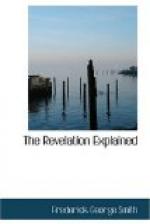Upon the opening of the first seal, John is summoned as with a voice of thunder by one of the living creatures to draw near; and the object that meets his vision is a white horse with its rider. The symbol is that of a victorious warrior, being drawn from the civil and military life of the Romans. The symbol is one of dignity. It does not consist of some inanimate object such as a mountain, a sea, or a river, neither is it a wild ferocious beast; but it is that of a living, active, intelligent being, and he, as denoted by various insignia, a conqueror. He rides a white horse, such as victors used in triumphal procession; his bow and crown are also symbols of victory. He goes forth conquering and to conquer, or to make conquests.
This symbol is a faithful representation of the early triumphs of Christianity in its aggressive conflict with the huge systems of error with which it had to contend. Some have supposed that the rider represented Jesus Christ; but this can not be, for many reasons, two of which I will give. First. Christ always appears on the symbolic stage in his own character, unrepresented by another, for the reason, as before stated, that there is no creature that can analagously represent Him who claims equality with God. Not one name or attribute peculiar to him is mentioned in the description. Second. There are four horsemen brought to view in this chapter, and the symbols all being drawn from the same department, must have the same general application. If the first horseman symbolizes a definite personage, so do the remaining three; but we should have great difficulty in identifying the last three, giving them an individual application.
Others make the first horseman a symbol of the gospel itself, but the gospel is not a living, active, intelligent agent, such as the symbol evidently is, but is only a system of the revealed truth. All congruity and appropriateness in the comparison is lacking.
But let us give this symbol further consideration. It is not enough that its interpretation alone be given, but the reader is justly entitled to a knowledge of the process by which we arrive at the truth. In the first place, we have a symbol of great dignity and excellence, and we must look for an object of corresponding character. The symbol is that of a living agent, and consequently, we must look for its fulfillment in an active, intelligent agent. The purity, or whiteness, of the horse on which the rider was seated would indicate an agency of mild, beneficent character. Finally, the symbol is drawn, as before stated, from the civil and military life of the Romans. Now, according to the laws of symbolic language, a symbol never represents an object like itself, but an analagous one in another department. A wild beast does not represent a wild beast, but something of analagous character. Seven fat and seven lean kine do not represent kine like themselves, but something analagous—seven




